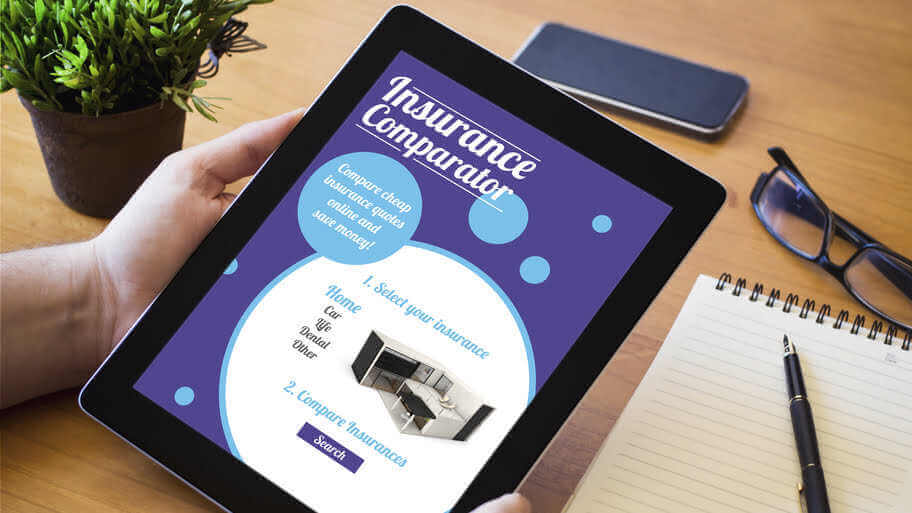Shopping around and comparing car insurance rates is one of the best ways to save money on car insurance. While it’s true that insurers look at many of the same factors when setting rates, each of them has their own calculation. It should come as no surprise that two companies may charge vastly different rates for the same driver.
While auto insurance rates tend to inch up over time, rates may go down for some drivers. By shopping around, you could find that your current insurer offers the best rates for the type of coverage you want. Or, you may find that switching is a must.
There are many factors that are considered when setting auto insurance rates, including your:
-
-
- Zipcode
- Annual mileage
- Marital status
- Driving history
- Vehicle information (ie. make, year, and model)
-
In some states, your credit history and/or gender may also be used to determine your rates.
Comparing Auto Insurance Rates
Despite using the same factors to set rates, each insurance company evaluates these factors in a unique way. It’s hard to know which company emphasizes a clean driving history or which one cares more about where you live.
To help you get started, below you’ll find average annual rates for both minimum and full coverage car insurance by company and by state.
Compare Rates by Age
While your driving history is important, it’s not the only factor that insurers look at when calculating your auto insurance rate. Age also has a significant impact on how much you’ll pay. It’s well known that teen drivers have extremely high insurance rates. Drivers over the age of 75 also tend to pay more.
We’ve compiled average annual rates from some of the top auto insurers in the country to make comparing options a little easier. Below are yearly rates for 20-year-olds by company and by state for both full and minimum coverage.
Company
Full coverage
Minimum coverage
Allstate
$3,706
$1,067
American Family
$2,374
$1,038
Farmers
$3,550
$1,421
Geico
$2,304
$715
Nationwide
$2,976
$1,369
Progressive
$3,546
$1,244
State Farm
$2,683
$979
Travelers
$2,874
$851
USAA
$2,298
$755
*USAA is only available to active duty military, veterans, and their families.
It should come as no surprise that car insurance rates for 20-year-old drivers vary from state to state. Here’s how your state stacks up.
State
Full coverage
Minimum coverage
Alabama
$3,632
$1,253
Alaska
$2,650
$836
Arizona
$3,294
$1,254
Arkansas
$3,850
$1,189
California
$3,564
$1,152
Colorado
$3,969
$1,137
Connecticut
$3,638
$1,785
Delaware
$4,741
$2,086
Florida
$4,890
$1,875
Georgia
$3,714
$1,639
Hawaii
$1,143
$370
Idaho
$2,124
$723
Illinois
$3,172
$1,147
Indiana
$2,409
$802
Iowa
$2,124
$528
Kansas
$3,478
$991
Kentucky
$4,915
$1,877
Louisiana
$5,873
$2,102
Maine
$2,469
$834
Maryland
$4,490
$2,045
Massachusetts
$2,618
$1,006
Michigan
$4,616
$1,766
Minnesota
$2,884
$1,052
Mississippi
$3,636
$1,250
Missouri
$3,543
$1,087
Montana
$3,543
$1,087
Nebraska
$2,915
$803
Nevada
$5,052
$2,223
New Hampshire
$2,448
$899
New Jersey
$3,883
$1,750
New Mexico
$2,784
$858
New York
$3,958
$1,747
North Carolina
$1,533
$505
North Dakota
$2,344
$677
Ohio
$2,298
$838
Oklahoma
$3,632
$1,018
Oregon
$2,599
$1,263
Pennsylvania
$3,380
$998
Rhode Island
$4,820
$1,971
South Carolina
$3,178
$1,271
South Dakota
$2,567
$592
Tennessee
$2,954
$933
Texas
$3,805
$1,444
Utah
$3,371
$1,385
Vermont
$2,410
$757
Virginia
$2,884
$1,079
Washington
$2,783
$1,068
Washington, D.C.
$3,785
$1,472
West Virginia
$3,442
$1,098
Wisconsin
$2,602
$776
Wyoming
$2,937
$647
Compare Rates for 35-Year-Olds
Drivers around the age of 35 typically pay much less for auto insurance than drivers in their 20s. Below you can compare the average car insurance rates for 35-year-old drivers from some of the top insurers in the country.
Company
Full coverage
Minimum coverage
Allstate
$1,994
$648
American Family
$1,454
$593
Farmers
$1,745
$639
Geico
$1,233
$370
Nationwide
$1,332
$545
Progressive
$1,739
$625
State Farm
$1,381
$473
Travelers
$1,426
$455
USAA
$1,238
$396
*USAA is only available to active duty military, veterans, and their families.
As you can see, auto insurance rates for 35-year-olds are much cheaper than those for 20-year-old drivers. In many states, 35-year-old drivers can pay less than $1,100 a year.
Here’s how your state stacks up:
State
Full coverage
Minimum coverage
Alabama
$1,701
$558
Alaska
$1,292
$396
Arizona
$1,637
$571
Arkansas
$1,854
$477
California
$1,967
$624
Colorado
$1,899
$489
Connecticut
$1,659
$814
Delaware
$2,027
$918
Florida
$2,775
$1,085
Georgia
$1,698
$709
Hawaii
$1,128
$365
Idaho
$1,027
$330
Illinois
$1,383
$478
Indiana
$1,133
$349
Iowa
$1,131
$237
Kansas
$1,791
$470
Kentucky
$2,423
$859
Louisiana
$2,986
$920
Maine
$1,074
$364
Maryland
$1,987
$908
Massachusetts
$1,163
$456
Michigan
$2,084
$876
Minnesota
$1,463
$535
Mississippi
$1,819
$549
Missouri
$1,694
$520
Montana
$1,773
$407
Nebraska
$1,401
$345
Nevada
$2,489
$965
New Hampshire
$1,143
$389
New Jersey
$1,901
$957
New Mexico
$1,461
$396
New York
$2,008
$934
North Carolina
$1,255
$402
North Dakota
$1,233
$355
Ohio
$1,066
$380
Oklahoma
$1,906
$458
Oregon
$1,355
$672
Pennsylvania
$1,525
$453
Rhode Island
$2,065
$833
South Carolina
$1,561
$588
South Dakota
$1,466
$299
Tennessee
$1,404
$406
Texas
$1,725
$599
Utah
$1,596
$640
Vermont
$1,074
$336
Virginia
$1,354
$506
Washington
$1,293
$461
Washington, D.C.
$1,867
$718
West Virginia
$1,580
$496
Wisconsin
$1,206
$354
Wyoming
$1,484
$336
Compare Rates for Drivers with a DUI
After being charged with a DUI, you can expect your auto insurance rate to increase. In some instances, it may go up by 75% or more. To try and lower your car insurance rate, the only factor you can control is your insurance company.
A DUI can impact your insurance rate for up to 10 years. After getting a DUI, the best thing you can do is shop around for the best price available.
Below you’ll find company averages for 35-year-old drivers before and after getting a DUI.
Company
Drivers with a clean record
Drivers with a DUI
Allstate
$1,994
$2,964
American Family
$1,454
$1,754
Farmers
$1,745
$2,531
Geico
$1,233
$2,935
Nationwide
$1,332
$2,848
Progressive
$1,739
$2,213
State Farm
$1,381
$2,455
Travelers
$1,426
$2,376
USAA
$1,238
$2,049
*USAA is only available to active duty military, veterans, and their families.
While you can expect your auto insurance rates to increase after a DUI, how much it will increase depends on where you live. Review the chart below to see how your state measures up.
State
Drivers with a clean record
Drivers with a DUI
Alabama
$1,701
$2,709
Alaska
$1,292
$2,003
Arizona
$1,637
$2,871
Arkansas
$1,854
$2,914
California
$1,967
$4,789
Colorado
$1,899
$2,989
Connecticut
$1,659
$3,696
Delaware
$2,027
$3,746
Florida
$2,775
$3,794
Georgia
$1,698
$3,145
Hawaii
$1,128
$4,357
Idaho
$1,027
$1,615
Illinois
$1,383
$2,661
Indiana
$1,133
$2,299
Iowa
$1,131
$1,914
Kansas
$1,791
$3,075
Kentucky
$2,423
$4,801
Louisiana
$2,986
$5,331
Maine
$1,074
$1,443
Maryland
$1,987
$3,775
Massachusetts
$1,163
$2,042
Michigan
$2,084
$5,543
Minnesota
$1,463
$2,956
Mississippi
$1,819
$2,869
Missouri
$1,694
$2,633
Montana
$1,773
$2,770
Nebraska
$1,401
$2,592
Nevada
$2,489
$3,855
New Hampshire
$1,143
$2,301
New Jersey
$1,901
$3,834
New Mexico
$1,461
$2,506
New York
$2,008
$3,405
North Carolina
$1,255
$2,627
North Dakota
$1,233
$2,182
Ohio
$1,066
$2,194
Oklahoma
$1,906
$2,670
Oregon
$1,355
$2,276
Pennsylvania
$1,525
$3,445
Rhode Island
$2,065
$3,910
South Carolina
$1,561
$2,576
South Dakota
$1,466
$2,297
Tennessee
$1,404
$3,115
Texas
$1,725
$3,019
Utah
$1,596
$2,384
Vermont
$1,074
$1,818
Virginia
$1,354
$2,698
Washington
$1,293
$2,245
Washington, D.C.
$1,867
$2,851
West Virginia
$1,580
$2,990
Wisconsin
$1,206
$2,238
Wyoming
$1,484
$2,791
Compare Rates for Drivers with Poor Credit
In most states, your credit history is one of the biggest factors that affect what you pay for car insurance. Insurers look at your credit history to determine the likelihood of you filing a claim.
While a poor credit score could double your rate in some cases, each insurance company weighs your credit score differently. In some instances, the impact fluctuates by state.
Below you’ll find full coverage rates for drivers aged 35 with poor credit.
Company
Drivers with good credit
Drivers with poor credit
Allstate
$1,994
$3,004
American Family
$1,454
$2,323
Farmers
$1,745
$2,725
Geico
$1,233
$1,758
Nationwide
$1,332
$1,772
Progressive
$1,739
$3,242
State Farm
$1,381
$3,381
Travelers
$1,426
$2,239
USAA
$1,238
$2,157
* USAA is only available to active duty military, veterans, and their families.
Certain states don’t allow auto insurance companies to use credit scores when setting rates. These include California, Hawaii, Massachusetts, and Michigan. It’s also important to remember that insurers use credit differently from state to state.
Below is a comparison of full coverage rates for drivers aged 35 with poor credit by state.
State
Drivers with good credit
Drivers with poor credit
Alabama
$1,701
$3,141
Alaska
$1,292
$1,921
Arizona
$1,637
$2,773
Arkansas
$1,854
$3,163
California
$1,967
$1,967
Colorado
$1,899
$3,172
Connecticut
$1,659
$2,745
Delaware
$2,027
$3,426
Florida
$2,775
$4,514
Georgia
$1,698
$2,917
Hawaii
$1,128
$1,128
Idaho
$1,027
$1,753
Illinois
$1,383
$2,250
Indiana
$1,133
$1,878
Iowa
$1,131
$2,122
Kansas
$1,791
$3,000
Kentucky
$2,423
$4,312
Louisiana
$2,986
$5,806
Maine
$1,074
$1,910
Maryland
$1,987
$3,188
Massachusetts
$1,163
$1,163
Michigan
$2,084
$2,084
Minnesota
$1,463
$2,824
Mississippi
$1,819
$3,289
Missouri
$1,694
$2,855
Montana
$1,773
$2,851
Nebraska
$1,401
$2,848
Nevada
$2,489
$3,559
New Hampshire
$1,143
$1,764
New Jersey
$1,901
$3,218
New Mexico
$1,461
$2,508
New York
$2,008
$4,356
North Carolina
$1,255
$1,701
North Dakota
$1,233
$2,230
Ohio
$1,066
$1,998
Oklahoma
$1,906
$3,111
Oregon
$1,355
$2,177
Pennsylvania
$1,525
$2,693
Rhode Island
$2,065
$3,614
South Carolina
$1,561
$3,114
South Dakota
$1,466
$3,059
Tennessee
$1,404
$2,746
Texas
$1,725
$2,766
Utah
$1,596
$2,885
Vermont
$1,074
$1,805
Virginia
$1,354
$2,521
Washington
$1,293
$1,547
Washington, D.C.
$1,867
$3,082
West Virginia
$1,580
$2,774
Wisconsin
$1,206
$3,114
Wyoming
$1,484
$2,428
Compare Auto Insurance Rates for Drivers with an At-Fault Accident
Your history of auto accidents will significantly impact your insurance rates. To get the best rate possible, it helps to compare each insurer’s average rates for drivers with an at-fault accident before you begin comparison shopping.
For drivers with an on-record accident, you’ll want to compare quotes one, three, and five years after the accident. This helps to ensure that you’re getting the best and cheapest rate possible.
Be aware that the company that offers the cheapest rates for a driver with a clean history may not offer the lowest rates for drivers with an at-fault accident on their record. This is why it’s important to compare rates with your circumstances in mind.
Below you’ll find full coverage rates for a 35-year-old driver that has an at-fault accident on their record by company.
Company
Drivers with a clean record
Drivers with a recent at-fault accident
Allstate
$1,994
$2,982
American Family
$1,454
$1,559
Farmers
$1,745
$2,498
Geico
$1,233
$2,004
Nationwide
$1,332
$2,105
Progressive
$1,739
$2,765
State Farm
$1,381
$1,794
Travelers
$1,426
$2,145
USAA
$1,238
$1,779
*USAA is only available to active duty military, veterans, and their families.
There are state regulations that limit how much insurance companies can increase your auto insurance rates after a crash. But one thing that’s for sure is that your rates will increase after an at-fault accident.
Below you’ll find full coverage rates for a 35-year-old driver that has an at-fault accident on their record by state.
State
Drivers with a clean record
Drivers with a recent at-fault accident
Alabama
$1,701
$2,460
Alaska
$1,292
$1,989
Arizona
$1,637
$2,493
Arkansas
$1,854
$2,738
California
$1,967
$3,339
Colorado
$1,899
$2,740
Connecticut
$1,659
$2,626
Delaware
$2,027
$2,802
Florida
$2,775
$3,990
Georgia
$1,698
$2,627
Hawaii
$1,128
$1,531
Idaho
$1,027
$1,452
Illinois
$1,383
$2,045
Indiana
$1,133
$1,655
Iowa
$1,131
$1,619
Kansas
$1,791
$2,618
Kentucky
$2,423
$3,401
Louisiana
$2,986
$4,292
Maine
$1,074
$1,559
Maryland
$1,987
$2,943
Massachusetts
$1,163
$1,959
Michigan
$2,084
$3,213
Minnesota
$1,463
$2,111
Mississippi
$1,819
$2,795
Missouri
$1,694
$2,347
Montana
$1,773
$2,474
Nebraska
$1,401
$2,106
Nevada
$2,489
$3,550
New Hampshire
$1,143
$1,715
New Jersey
$1,901
$3,008
New Mexico
$1,461
$2,064
New York
$2,008
$2,759
North Carolina
$1,255
$2,172
North Dakota
$1,233
$1,776
Ohio
$1,066
$1,579
Oklahoma
$1,906
$2,678
Oregon
$1,355
$2,070
Pennsylvania
$1,525
$2,352
Rhode Island
$2,065
$2,919
South Carolina
$1,561
$2,246
South Dakota
$1,466
$1,934
Tennessee
$1,404
$2,144
Texas
$1,725
$2,944
Utah
$1,596
$2,383
Vermont
$1,074
$1,486
Virginia
$1,354
$2,045
Washington
$1,293
$1,821
Washington, D.C.
$1,867
$2,692
West Virginia
$1,580
$2,294
Wisconsin
$1,206
$1,686
Wyoming
$1,484
$2,045
Tips to Compare Car Insurance Rates and Quotes
Although it does take some time and effort to compare car insurance rates, the good news is that each quote you receive should be free. While some insurers require a down payment to begin coverage, quote estimates should always be free of charge.
Now, here’s what you need to do to get started comparing car insurance rates and quotes.
1) Gather Necessary Information
Because insurers tend to use specific details to set rates, there are some things you’ll want to have on hand to make price comparison as easy as possible.
Personal Information – This includes your address, date of birth, driver’s license, occupation, and marital status. You must provide this information for everyone included in the policy.
Vehicle Information – This includes vehicle identification number (VIN), mileage, and date of purchase.
Driving History – This includes all violations, claims, and tickets that you’ve had over the past 3-5 years. You’ll also want to provide information about any driving courses you’ve completed.
Current Insurance Information – Provide your current or previous insurer’s name for anyone on the policy. Most insurers want to see your coverage history to ensure that you’re currently covered and have a good track record of maintaining coverage.
2) Choose the Right Liability Coverage
Auto insurance offers financial protection, and not just for your car. If you’re involved in a serious accident, damage and injuries can easily cost hundreds of thousands of dollars. If you’re at fault for a serious accident, victims could sue you. This could result in assets being seized.
Liability auto insurance protects you from these worst-case scenarios. This is why it’s important to choose the right auto liability limits.
So, how much liability coverage should you have? It’s recommended that you have as much coverage as your net worth.
Liability coverage is available in several levels, such as 50/100/50 or 250/500/250. These numbers represent the individual injuries/total injuries/property damage.
Liability insurance is available in thousand-dollar increments, so when you choose a 250/500/250 policy, your coverage includes:
-
-
-
- $250,000 for bodily injuries per person you injure in a crash
- $500,000 total for all bodily injuries
- $250,000 for damage to any property (ie. cars, buildings, etc.)
-
-
Make sure that the coverage you choose provides the right amount of financial cushion. It’s also important to know what’s required in your state. Some states require personal injury protection, uninsured/underinsured motorist coverage, and/or medical payments coverage.
3) Determine if You Need Full Coverage Insurance
It’s important to note that liability coverage doesn’t pay for your injuries or damages to your car. It also doesn’t cover any injuries sustained by passengers in the event of a crash you caused. This is where full coverage car insurance comes into play.
Full coverage car insurance includes liability coverage as well as comprehensive and collision coverage. Collision insurance covers the following:
-
-
-
- Damage to your car in an at-fault accident
- Damage to your car if you hit an object (i.e. fence, pole, mailbox, etc.)
- Damage to your car if someone else hits you
-
-
On the other hand, comprehensive insurance covers the value of your car if it’s stolen or damaged by weather, fire, floods, falling objects, explosions, or crashes involving an animal. It also covers damage caused by civil disturbances.
4) Collect and Compare Quotes
Get as many car insurance quotes as possible so that you can ensure you’re getting a good deal. Not only should you compare quotes from regional companies, you’ll also want to get quotes from big insurers such as Progressive, Geico, and State Farm.
When comparing car insurance rates, be sure that each quote includes all of the same details, such as coverage levels, deductibles, drivers and cars, and discounts.
Whether you’re looking for cheap car insurance for imports, two-week car insurance for under 21s, or other coverage types, shopping around is the only way to get the best bang for your buck. It’s important to spend the time comparing car insurance rates to find what is right for you.
Frequently Asked Questions (FAQs)
Can I Renew Car Insurance with a Claim Pending?
Renewing car insurance whilst a claim is pending is possible. Most insurers will quote you auto insurance rates with the assumption that the claim has been settled. However, when shopping for quotes, be sure that you’re honest about any outstanding claims that you have.
Does DUI Diversion Affect Car Insurance?
Most likely, yes. Depending on the circumstances of your DUI, you may face significantly higher premiums. Being charged with a DUI means that you’re a higher-risk driver in the eyes of any auto insurer. Depending on where you live and the circumstances, your rates may be three to five times higher.
Can I Insure a Car with a Salvage Title?
Cars with salvage titles can’t be driven on public roads, which means insurance can’t be purchased on the vehicle. However, if a salvage car has been refurbished and rebuilt, it may qualify for a rebuilt title. If you have a USAA car insurance salvage title or any other salvage title, chances are you can’t insure the vehicle.
Featured Image: Twenty20






